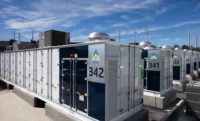Energy storage is a hot topic in California, where lawmakers are mandating that the state’s three biggest utility companies provide 33% of their electrical energy from renewable sources by 2020. Southern California Edison, Pacific Gas & Electric and San Diego Gas & Electric are mandated to buy a total of at least 1300 MW of energy storage to help make the plan work.
But a utility that isn’t part of the mandate is installing one of the largest lithium-ion batteries in the state. The battery has a rating of 30 MW and 20 MW-hours. The utility, Imperial Irrigation District, also is creating its battery energy storage system (BESS) to serve multiple purposes other than just bringing renewable energy to the grid, although that is an important part of its plan, too.
Imperial’s project illustrates how a BESS can be deployed to solve a variety of grid challenges while it responds to demand changes.
Imperial’s energy storage systemwill aid grid flexibility, smooth out frequency variations and provide voltage support on Imperial’s network. The system also will provide operational support for the energy management system.
California’s storage mandate is the first in the United States, but utilities in other states also are building storage. According to news reports, Hawaiian Electric Co. is negotiating with three battery energy storage developers to provide up to 200 MW of storage from renewable energy sources on Oahu. On the mainland, most of the BESS deployed in the nation in 2014 was in the service territory of grid operator PJM Interconnection. The storage systems provide fast-response frequency regulation for the PJM market, which extends over 13 states from the Atlantic Coast to Illinois. Last year, Texas transmission and distribution company Oncor announced a plan to install 5,000 MW of battery energy storage on the Texas grid.
Energy storage helps grid operators address imbalances caused by adding variable renewable resources to the utility’s grid. Energy storage also can provide spinning reserve and area control error correction functions in support of system operations for a balancing authority.
There are other storage technologies, of course. Pumped hydro and compressed air energy storage are bigger in terms of megawatt rating and megawatt-hour capacity. Other technologies include capacitors, flywheels and thermal storage.
But batteries are widely used because they can serve a middle range of system power ratings and provide the most breadth of services in storage. Batteries also excel in situations where a fast response time is needed.
A battery storage system can respond in a few cycles where a conventional generator may take several minutes. This can make a significant difference when trying to correct frequency issues or meet control performance standards established by the Federal Energy Regulatory Commission.
Another feature of lithium-ion batteries is that they can recover very quickly. A 30-MW battery system can discharge at a rate of 0 to 30 MW, but it also can recharge at up to 30 MW. This gives a 30-MW battery system a dynamic range of 60 MW. This feature allows a battery system state of charge (SOC) to be controlled by operating it within its dynamic range at a point above or below the 0-MW point.
Controlling the battery system SOC is critical for maintaining the usefulness of a battery system with a limited energy capacity. Controlling the battery system SOC by coordinating the operating point offset with conventional generation will ensure that the battery can continue to address the fast-response needs of the network, while the conventional generation is used to control the battery SOC and also address the more slowly moving system conditions.
Using this type of control, the battery system becomes a much more flexible tool for system operations than a simple charge and discharge unit. Coordinating the battery system with conventional generators gives the best of both worlds—fast response and sustained energy—which neither system alone can achieve.
James R. Smith, Ph.D., PE, senior project engineer, specializes in power system modeling and dynamic studies services for POWER Engineers Inc.




Post a comment to this article
Report Abusive Comment